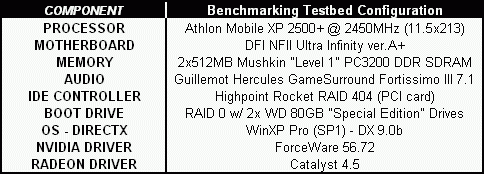| BENCHMARKING PLATFORM & TEST PLAN... |

The video benchmarking was done using my personal PC; the basic configuration details are shown in the table at right.
Naturally, it wouldn't make much sense to benchmark the 5900XT by itself, as that would give little basis of comparison for how it stacks up against other currently available video cards. For that comparison, I used a Sapphire Radeon 9800 Pro (the card I use in my personal PC) and a PowerColor Radeon 9600 Pro "Bravo Edition" card temporarily purloined from my son's PC. Both were tested using the Catalyst 4.5 reference driver set, downloaded from the ATI driver webpage. These two cards should provide an excellent match-up with the 5900XT, since the highly regarded 9800 Pro is the most popular high-performance 3D card currently available, and the 9600 Pro enjoys a similar reputation among the mid-range cards. Price-wise, the two ATI models bracket the GeforceFX 5900XT cards, with the 9800 Pro going for $210 and up in 128MB memory versions, and the 9600 Pro selling in the $125 - $150 range currently.
For the testing of these three video cards, I selected a total of six benchmarks, consisting of both "synthetic" multi-test video benchmarks and actual games, and employing both OpenGL and Direct3D rendering modes:- 3DMark03 Build 320 Multi-test Video Benchmark (DirectX 9)
- 3DMark2001 SE Build 330 Multi-test Video Benchmark (DirectX 8)
- AquaMark3 Multi-test Video Benchmark (DirectX 9)
- Unreal Tournament 2003 Demo v.226 Benchmark Test (DirectX 8 game)
- Quake 3 Arena "Demo002" Timedemo (OpenGL game)
- GL Excess v.1.2b Multi-test Video Benchmark (OpenGL)
For each of these tests, the benchmark was run under four different conditions on each video card:
- Default core & memory clockspeeds, anti-aliasing & anisotropic filtering off
- Default core & memory clockspeeds, 4x anti-aliasing & 8x anisotropic filtering
- Overclocked core & memory settings, anti-aliasing & anisotropic filtering off
- Overclocked core & memory settings, 4x anti-aliasing & 8x anisotropic filtering
Considering the relative ease with which today's video cards can be overclocked and the resulting free speed boost, the inclusion of overclocked data has become "standard operating procedure" in studies of this sort. Including data to quantify the impact of anti-aliasing (AA) and anisotropic filtering (AF) has also become de rigueur, since these visual quality enhancement techniques are so widely used now. And, despite the advances in 3D technology, they can still result in a very significant performance penalty, especially AA.
All of the testing was done at a screen resolution of 1024x768 and 32-bit color depth, with the exception of the Quake 3 Arena timedemo, which was run at 1600x1200x32. This higher resolution setting was used because this older game just doesn't "push" a video card hard enough at 1024x768.
Regarding the overclocked core and memory speed settings, I used the maximum stable speeds that I have determined in the past by trial & error for the 9800 Pro (400/702) and 9600 Pro (515/720) cards. For the 5900XT, I used the empirical approach of independently increasing the core and memory clockspeeds until instability was encountered. A maximum stable core and memory frequencies I was able to obtain on this MSI card were 494MHz and 774MHz, respectively. That's pretty respectable, especially for the core. Clockspeed adjustments were made using a couple of very popular third-party video card "tweaking" utilities: Guru3D's Riva Tuner for the 5900XT, and Rage3D's Radeon Tweak Utility for the two Radeon cards.
I should point out that the maximum clockspeeds attainable on my 9800 Pro are only very modestly higher than the stock speeds. That's because the card is actually a 9800 non-Pro that has been flashed with the Pro BIOS (read all about it HERE). A "real" 9800 Pro would almost certainly go a bit higher.
So, let's move on to the benchmark results and their interpretation....
 |
 |